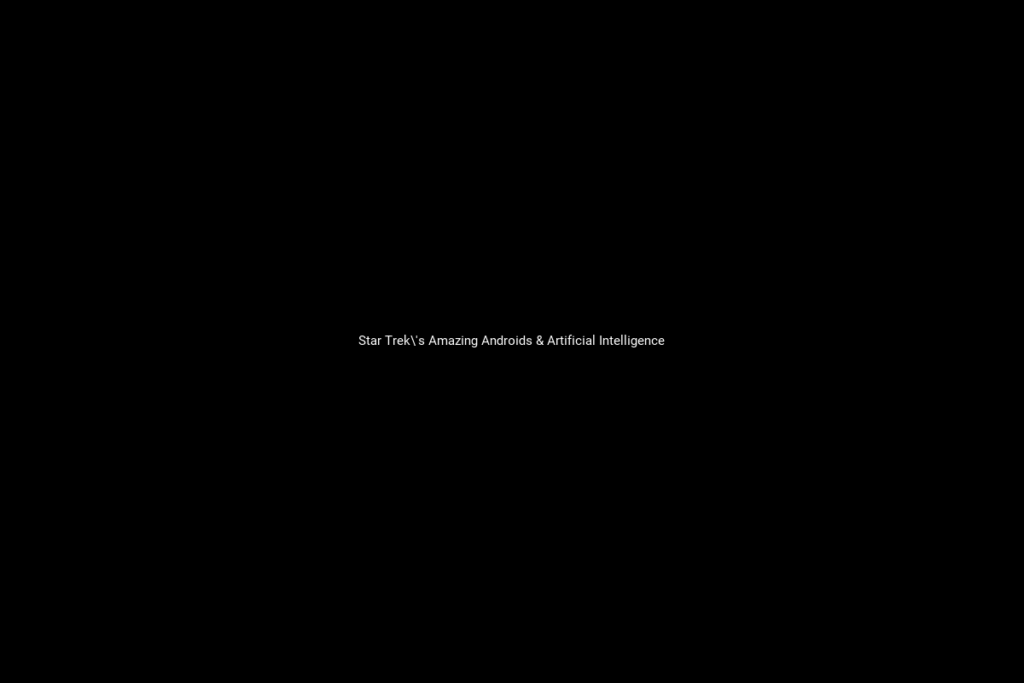On their 1983 hit song, “Mr. Roboto”, super pop group Styx wailed “Domo Arigato Mr. Roboto” – translated from Japanese as “Thank you very much, Mr. Robot.” It was four years before the syndicated debut of TV’s landmark “Star Trek: The Next Generation”, but it was as if this American music group was thanking Data – ever efficient artificial lifeform or android on Captain Picard’s Enterprise. Data isn’t the only amazing android or A.I. entity of “Star Trek”, but he’s surely the most famous. Other mechanized marvels are a towering, smoothly bald figure and a slight framed, yet disarming young lady named after the Hindi word for beloved.
Androids
Data (Next Generation)
Data was created by a brilliant scientist, Dr. Noonian Soong (Brent Spiner), and brought to life by the actor Brent Spiner. Both characters were dreamed up by “Star Trek: The Next Generation” creator Gene Roddenberry.
Introduced in the pilot, “Encounter At Farpoint”, Data processes information at super fast speed, boasts enormous physical strength, resilience and can mimic the speech patterns of anyone. As he revealed to Dr. McCoy, “I remember every fact I’m exposed to, sir.” Always dynamic actor Spiner evolved his delightful Data performance over the years. Early on, TNG’s golden android appears childlike or clumsy in his social skills, until he came to a place where Data’s more comfortable operating around emotionally infused humanity or alien life. Still, it would take the theatrical movies, “Generations” and “First Contact” for Data to exploit his emotion chip. When he did, it made him welcome revulsion over drinking green booze and gave him seductive lust from a stunning Borg (Alice Krige) Queen.
Lal (Next Generation)
Data was lonely. He wanted android company, so he created another of his electronic kind. In the TNG episode, “The Offspring”, Data finishes his fabrication and consults Counselor Troi as to the final physical and even species of his creation. He settles on a young, Human girl and calls her Lal – which means beloved in the Hindi language. At first, Lal can barely carry on a conversation or even catch a ball. Although Lal (Hallie Todd) tries her best to fit in and become one of the Enterprise crew, something holds her back. Finally, she passes on – or goes offline – in a tear jerker finale.
Ruk (Star Trek)
Played by the towering Ted Cassidy – the actor stood 6ft 9 in – Ruk was built by the Ancient Ones – fantastically advanced aliens long since gone. Captain Kirk and crew encounter him while on a mission to planet Exo III. The away team’s goal is to learn what has happened to Dr. Roger Korby, an old flame of Nurse Christine Chapel, played by Majel Barrett Roddenberry. Ruk shocked all who saw him as an enormous bald android. Conflicting aesthetically with his intimidating physique, he wore a puffy pastel colored robe which only added to his weird artificial persona. After trying to rebel, he’s destroyed by Korby with a hand phaser. His most famous line was when he shouted the memorable, “That was the equation. EXISTENCE! SURVIVAL… must cancel out programming!”

Automated Personnel Unit (Voyager)
This silvery android’s voice sounded deceptively calm and controlled for a device so intent on mayhem. When Engineer B’Elanna Torres encounters such an android its power module or battery is badly damaged. She manages to fix it, but regrets her repair task, when she learns it was simply created to fight a war between two distinct groups – the Pralor and Cravic. Unfortunately, the low budget of this episode demanded that the actors – playing the androids – don really cheap looking masks.
Mudd’s Androids (Star Trek)
In the episode, “I, Mudd”, Harcourt Fenton Mudd (Roger C. Carmel) returns to wreck hysterical havoc with Kirk’s Enterprise crew. He’s not alone, but in the company of highly advanced androids who promise near eternal life to anyone who wishes their brains transplanted into an android body. While this seemed like a good deal to some, no crew member on the starship took him up on his offer.
Artificial Intelligence
Enterprise Computer
We talk to computers now. We use computer driven voice menus when we call a bank for a balance or while waiting for customer service. iPhones and Android smartphones have voice activated assistants to help with calendar maintenance and simple browsing search functions. When “Star Trek” premiered, the notion of speaking to a computer and getting a reply was definitely beyond cutting edge. Both Captains Kirk and Picard relied heavily on their computer to provide answers and engage in various starship chores.
Doc (Voyager)
Physicians need a good bedside manner for patients. This holographic medical doctor’s bedside manner is definitely a work in progress. Played by chameleon actor Robert Picardo (The Wonder Years), Doc is composed of highly focused light particles called photons. His holographic matrix is supported and augmented by skillfully projected force fields. It means when Doc examines a patient, they feel his ministrations. Doc displays much more emotional maturity than Data, though some might say he’s over emotional. Still, his brilliant smile and twinkling eyes is a comfort to Captain Janeway’s crew, and he even has time to flirt with resident Borg babe, Seven Of Nine.
Guardian Of Forever
In the classic TOS episode, “City On The Edge Of Forever”, starring guest actress Joan Collins (Dynasty) Kirk and Spock are transported back into the past to search for a psychotic Dr. McCoy. The artificial lifeform which makes this possible is a giant, glowing donut like structure called the Guardian of Forever. Though even calling the thing an artificial lifeform may be somewhat innaccurate, as when Kirk asks it, ‘Are you machine, or being?’ It answers, “I am both and neither. I am my own beginning, my own ending.” http://en.wikipedia.org/wiki/The_Offspring_(Star_Trek:_The_Next_Generation) http://www.trektoday.com/reviews/tng/offspring.shtml http://www.songfacts.com/detail.php?id=1461

Recent Comments